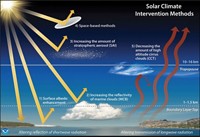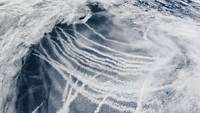Advertisement
Grab your lab coat. Let's get started
Welcome!
Welcome!
Create an account below to get 6 C&EN articles per month, receive newsletters and more - all free.
It seems this is your first time logging in online. Please enter the following information to continue.
As an ACS member you automatically get access to this site. All we need is few more details to create your reading experience.
Not you? Sign in with a different account.
Not you? Sign in with a different account.
ERROR 1
ERROR 1
ERROR 2
ERROR 2
ERROR 2
ERROR 2
ERROR 2
Password and Confirm password must match.
If you have an ACS member number, please enter it here so we can link this account to your membership. (optional)
ERROR 2
ACS values your privacy. By submitting your information, you are gaining access to C&EN and subscribing to our weekly newsletter. We use the information you provide to make your reading experience better, and we will never sell your data to third party members.
Atmospheric Chemistry
Solar geoengineering research could get funding injection
National Academies study recommends more research on these potentially risky approaches to cool the planet
by Katherine Bourzac
March 29, 2021

The risks of climate change are becoming clear, and there has been relatively little action to rein in the greenhouse gases that cause it. Given this dire picture, scientists should seriously—albeit cautiously—assess the potential of solar geoengineering, recommends a study by the National Academies of Sciences, Engineering, and Medicine.
The report recommends that the US invest $100–200 million in solar geoengineering research over the next 5 years, in cooperation with other countries, in order to determine whether the technology should be on the table as a potential way to avert catastrophic climate change. “Our current understanding of solar geoengineering is not sufficient to guide policy decisions,” said Christopher B. Field, chair of the study committee, in a public briefing. Field directs the Stanford Woods Institute for the Environment.
Solar geoengineering, if effective, could cool Earth. Researchers have proposed injecting gases into the stratosphere or intervening in cloud formation in order to reflect sunlight and heat away from the planet. These strategies would not address the root cause of climate change—greenhouse gas emissions—and they pose uncertain environmental and economic risks of their own, Field said.
Reached by phone, study contributor and California Institute of Technology atmospheric chemist Paul O. Wennberg explained some of the scientific uncertainties. The National Academies report recommends further research on three potential approaches, all of which need further research because they rely on poorly understood atmospheric chemistry and physics.
The most mature technique is inspired by the aftereffects of large volcanic eruptions, which inject plumes of sulfur dioxide and hydrogen sulfide into the atmosphere. These gases rapidly spread and form aerosol particles that cool the planet by reflecting sunlight. To mimic this, scientists have proposed stratospheric aerosol injection, which would use planes to discharge gases that would form similar reflective aerosols.
There is good evidence that this would have a cooling effect, Wennberg says. However, there could be other consequences. Stratospheric aerosol injection would make the sun’s light more diffuse, which could affect ecosystems, farms, and solar electricity installations. There would also be complex effects on stratospheric ozone chemistry.
The National Academies study also recommends research on marine cloud brightening, an idea inspired by ship tracks. Ship emissions seed the formation of clouds of highly concentrated, very reflective sulfur aerosols: the bright formations can be seen from space. But brightening clouds by design, and predicting the consequences, is currently not possible. Marine clouds are a major driver of climate, because they very effectively prevent heat absorption by the ocean, Wennberg says. They are also one of the biggest uncertainties in today’s climate models, which don’t have the spatial resolution to accurately predict the effects of these relatively small formations.
The third approach considered in the National Academies report also deals in cloud manipulation. Thinning high-altitude cirrus clouds could allow more heat to reflect off the Earth. But so far it’s not clear how to change these clouds’ properties and what the effects would be. Studies so far have been contradictory. “We have no idea if this works,” Wennberg says.
The research proposed by the National Academies study would have a practical bent: to help policymakers decide whether to pursue solar geoengineering. And even if solar geoengineering is ultimately rejected as impractical, the research could yield new insights about atmospheric chemistry, and drive the development of climate models that provide a clearer picture of the stratosphere and of clouds, Wennberg says.
For all three approaches, the National Academy report recommends research primarily based on computer modeling and lab experiments. At the briefing, University of California, Davis, law professor Albert C. Lin said outdoor experiments should only be conducted when there is no other way to make observations, and that any outdoor releases should be limited to quantities of material two orders of magnitude lower than those likely to pose an environmental risk.
Lin and other report authors emphasized that social science research about solar geoengineering will be just as important as technical research and should be funded accordingly. “The viability of these technologies is as much defined by the social domain as the natural sciences domain,” Wennberg says. For example, will communities accept the risk of regional weather changes that might come with geoengineering efforts? Lin said that funders should prioritize projects that include collaborators from multiple countries, require researchers to follow a code of conduct, and ensure that experimental plans and data are publicly available.




Join the conversation
Contact the reporter
Submit a Letter to the Editor for publication
Engage with us on Twitter